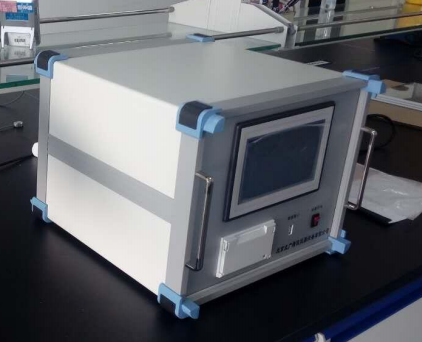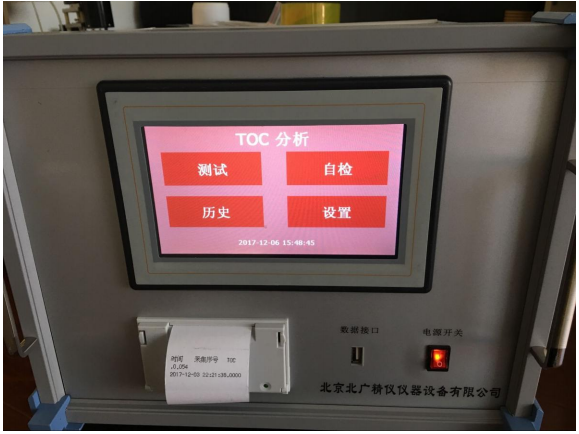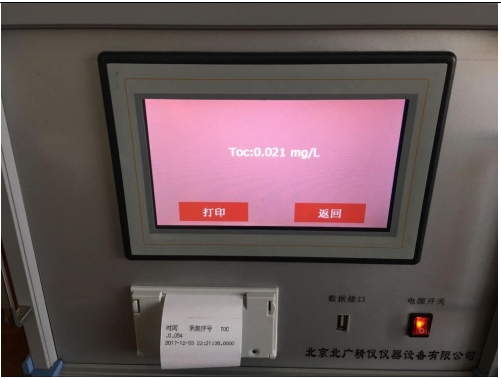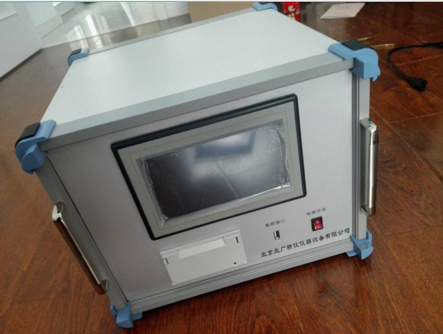電導(dǎo)率法TOC分析儀 使用與操作方法
開始檢測并計入檢測次數(shù),檢測完畢后顯示最后一次檢測結(jié)果,其中幾次檢測的結(jié)果均自動保存在查詢記錄當(dāng)中。檢測次數(shù)的設(shè)置方式為:用“選擇”鍵移動光標(biāo),用“設(shè)置”鍵修改數(shù)字,按“確定”鍵進(jìn)行確認(rèn),進(jìn)入分析界面。先進(jìn)行四次沖洗過程
電導(dǎo)率法TOC分析儀 水中TOC的監(jiān)測
我們的生活離不開水,若相當(dāng)多的有機(jī)污染物存在于水中,將直接影響水體的質(zhì)量,對我們的生活和生產(chǎn)造成危害,因此水和廢水的監(jiān)測,越來越引起人們的重視。其中水體中總有機(jī)碳(TOC)含量的檢測,日益引起關(guān)注。它是以碳含量表示水體中有機(jī)物質(zhì)總量的綜合指標(biāo)。TOC的測定一般采用燃燒法,此法能將水樣中有機(jī)物全部氧化,可以很直接地用來表示有機(jī)物的總量。因而它被作為評價水體中有機(jī)物污染程度的一項(xiàng)重要參考指標(biāo)。
設(shè)備標(biāo)準(zhǔn)配置
試驗(yàn)主機(jī)一臺
采集管兩條
電源線一條
控制系統(tǒng)一套
數(shù)據(jù)采集系統(tǒng)一套
產(chǎn)品使用說明書一份
產(chǎn)品合格證一份
性能規(guī)格:
測量范圍:0.01mg/L~1.000 mg/L(此處可調(diào))
精度:?4%測試范圍
分辨率:0.001mg /L
分析時間:連續(xù)分析
響應(yīng)時間:6分鐘之內(nèi)
檢測極限:0.001mg /L
樣品溫度:1- 95℃
重復(fù)性誤差:≤3%
電源要求/功能:220V
顯示屏:彩色觸摸屏
操作控制:無線藍(lán)牙技術(shù)
使用與操作方法
開始檢測并計入檢測次數(shù),檢測完畢后顯示最后一次檢測結(jié)果,其中幾次檢測的結(jié)果均自動保存在查詢記錄當(dāng)中。檢測次數(shù)的設(shè)置方式為:用“選擇”鍵移動光標(biāo),用“設(shè)置”鍵修改數(shù)字,按“確定”鍵進(jìn)行確認(rèn),進(jìn)入分析界面。先進(jìn)行四次沖洗過程
直接法測定TOC值的方法原理
將水樣酸化后曝氣,使各種碳酸鹽分解生成二氧化碳而驅(qū)除后,再注入高溫燃燒管中,可直接測定總有機(jī)碳。但由于在曝氣過程中會造成水樣中揮發(fā)性有機(jī)物的損失而產(chǎn)生測定誤差,因此其測定結(jié)果只是不可吹出的有機(jī)碳值。
電導(dǎo)率法
使用紫外燈將水中有機(jī)物轉(zhuǎn)化為二氧化碳,二氧化碳溶解在水中形成碳酸根離子.有機(jī)物轉(zhuǎn)化前后都測量電導(dǎo)率,通過電導(dǎo)率的差值可算出增加的碳酸根含量,就可以算出水中的TOC了。
標(biāo)準(zhǔn)貯備液的制備
(1)有機(jī)碳標(biāo)準(zhǔn)貯備液:稱取干燥后的適量KHC8H4O4,用水稀釋,一般貯備液的濃度為400mg/L碳。
(2)無機(jī)碳標(biāo)準(zhǔn)貯備液:稱取干燥后適量比例的碳酸鈉和碳酸氫鈉,用水稀釋,一般貯備液的濃度為400mg/L無機(jī)碳。
差減法測定TOC值的方法原理
水樣分別被注入高溫燃燒管(900℃)和低溫反應(yīng)管(150℃)中。經(jīng)高溫燃燒管的水樣受高溫催化氧化,使有機(jī)化合物和無機(jī)碳酸鹽均轉(zhuǎn)化成為二氧化碳。經(jīng)反應(yīng)管的水樣受酸化而使無機(jī)碳酸鹽分解成為二氧化碳,其所生成的二氧化碳依次導(dǎo)入非分散紅外檢測器,從而分別測得水中的總碳(TC)和無機(jī)碳(IC)。總碳與無機(jī)碳之差值,即為總有機(jī)碳(TOC)。
應(yīng)用范圍
該儀器可用于檢測制藥工業(yè)中純化水、注射用水和去離子水中有機(jī)碳的濃度;也可用于半導(dǎo)體行業(yè)中超純水TOC的檢測。
在制藥領(lǐng)域和生物化學(xué)領(lǐng)域清潔驗(yàn)證過程中,可用于驗(yàn)證清潔效果。
該儀器具有在線檢測功能,可以在線監(jiān)測制藥工業(yè)的制水系統(tǒng)、半導(dǎo)體工業(yè)的超純水制備系統(tǒng)和晶片工藝過程、電廠去離子水制備過程等。
TOC分析儀的水樣中TOC的分析步驟
水中的有機(jī)物質(zhì)的含量,以有機(jī)物中的主要元素一碳的量來表示,稱為總有機(jī)碳。TOC的測定類似于TOD的測定。在950℃的高溫下,使水樣中的有機(jī)物氣化燃燒,生成CO2,通過紅外線分析儀,測定其生成的CO2之量,即可知總有機(jī)碳量。
計算
差減法:總有機(jī)碳(mg/L)=總碳-無機(jī)碳
直接法:總有機(jī)碳(mg/L)=總碳
工作原理
本儀器采用紫外氧化的原理,將樣品中的有機(jī)物氧化為二氧化碳,二氧化碳的測試采用的是直接電導(dǎo)率法,通過測試經(jīng)過氧化反應(yīng)的樣品的總碳含量和未經(jīng)過氧化反應(yīng)的樣品總無機(jī)碳的含量差值來測定總有機(jī)碳含量,即:總有機(jī)碳(TOC)=總碳(TC)-總無機(jī)碳(TIC)。
工作原理
本儀器采用紫外氧化的原理,將樣品中的有機(jī)物氧化為二氧化碳,二氧化碳的測試采用的是直接電導(dǎo)率法,通過測試經(jīng)過氧化反應(yīng)的樣品的總碳含量和未經(jīng)過氧化反應(yīng)的樣品總無機(jī)碳的含量差值來測定總有機(jī)碳含量,即:總有機(jī)碳(TOC)=總碳(TC)-總無機(jī)碳(TIC)。
產(chǎn)品特點(diǎn):
1.儀器采用便攜設(shè)計,使用輕便,方便移動至取樣點(diǎn)。
2.采用嵌入式系統(tǒng),觸摸屏設(shè)計,純中文操作方便簡易。
3.針對制藥用水(TOC含量在1000ppb以下)總有機(jī)碳含量的檢測設(shè)計,進(jìn)行檢測。
4.配備大量的儲存空間,能夠存儲大量的測試數(shù)據(jù)。
5.中文打印,輸出測試參數(shù)、測試結(jié)果。
6.在使用、貯存和更換過程中不需要?dú)怏w或試劑,無移動部件,減少維修和維護(hù)成本。
7.當(dāng)測試樣品濃度超過規(guī)定限度,儀器能夠自動報警,并輸出控制信號。
8.符合國家2010版《中國藥典》規(guī)定的測試方案,可以提供IQ/OQ/PQ服務(wù)。
儀器特點(diǎn)
1. 采用24 位A/D 轉(zhuǎn)換技術(shù)和32bin 信號處理技術(shù)的應(yīng)用;
2. 自動檢漏控制系統(tǒng):實(shí)時檢測氣體流量,同時配有報警設(shè)置,防止氣體泄漏;
3. TIC 反應(yīng)池加熱、制冷、脫水、液位監(jiān)控4 位一體技術(shù);
4. 自動微量進(jìn)樣,樣品進(jìn)樣量可控;
5. 具有在線設(shè)定、實(shí)時監(jiān)控、自我檢定、流速控制的功能;
6. 實(shí)時檢測軟件:樣品曲線在同一坐標(biāo)下繪制,直觀顯示重復(fù)性;時刻監(jiān)測儀器運(yùn)行狀態(tài),對比實(shí)測參數(shù)和設(shè)定參數(shù)的差異;
7. 先進(jìn)的微信號處理系統(tǒng),具有在線設(shè)定、實(shí)時監(jiān)控、自我檢定、流速控制等幾大優(yōu)勢, 保證儀器性能優(yōu)越,操作安全;
8. 自動檢漏控制系統(tǒng):實(shí)時檢測氣體流量,同時配有報警設(shè)置,防止氣體泄漏,最大限度保證操作者和儀器的安全;
9. 先進(jìn)的流速控制信號處理技術(shù)的應(yīng)用,屏蔽流速波動帶來的影響,保證讀數(shù)穩(wěn)定準(zhǔn)確; 10.先進(jìn)的實(shí)時檢測軟件:樣品曲線在同一坐標(biāo)下繪制,直觀顯示重復(fù)性;時刻監(jiān)測儀器運(yùn)行狀態(tài),對比實(shí)測參數(shù)和設(shè)定參數(shù)的差異;
10. 根據(jù)不同樣品的不同性質(zhì),設(shè)定不同的控制溫度,以使樣品徹底消解,使測量數(shù)據(jù)更為準(zhǔn)確可靠;
11. 儀器內(nèi)部采用先進(jìn)的弱電設(shè)計方式,操作安全;
注意事項(xiàng)
● 該儀器初始的包裝材料需小心保存,安裝需由本公司的專業(yè)技術(shù)人員進(jìn)行操作。
● 若儀器由于任何原因必須返修,必須將其裝入原紙箱中以防運(yùn)輸途中損壞。
Usage and operation methods
Start the detection and count the number of detections. After the detection is completed, the last detection result will be displayed, and the results of several detections will be automatically saved in the query record. The setting method for the detection frequency is: use the "Select" key to move the cursor, use the "Set" key to modify the number, press the "OK" key to confirm, and enter the analysis interface. Perform four flushing processes first
Monitoring of TOC in water
Our lives cannot do without water. If a considerable amount of organic pollutants exist in water, it will directly affect the quality of the water and pose a threat to our lives and production. Therefore, monitoring water and wastewater is increasingly attracting people's attention. The detection of total organic carbon (TOC) content in water bodies is increasingly attracting attention. It is a comprehensive indicator that represents the total amount of organic matter in water bodies based on carbon content. The determination of TOC generally adopts the combustion method, which can completely oxidize the organic matter in the water sample and can be directly used to indicate the total amount of organic matter. Therefore, it is regarded as an important reference indicator for evaluating the degree of organic pollution in water bodies.
Equipment standard configuration
One experimental host
Two collection tubes
One power cord
One set of control system
A set of data collection system
One copy of the product user manual
One copy of product qualification certificate
Performance specifications:
Measurement range: 0.01mg/L to 1.000 mg/L (adjustable here)
Accuracy: ? 4% Test range
Resolution: 0.001mg/L
Analysis time: continuous analysis
Response time: within 6 minutes
Detection limit: 0.001mg/L
Sample temperature: 1-95 ℃
Repetitive error: ≤ 3%
Power requirement/function: 220V
Display screen: Color touch screen
Operation control: Wireless Bluetooth technology
Usage and operation methods
Start the detection and count the number of detections. After the detection is completed, the last detection result will be displayed, and the results of several detections will be automatically saved in the query record. The setting method for the detection frequency is: use the "Select" key to move the cursor, use the "Set" key to modify the number, press the "OK" key to confirm, and enter the analysis interface. Perform four flushing processes first
Principle of direct method for determining TOC value
After acidifying the water sample and aerating it, various carbonates are decomposed to produce carbon dioxide, which is then removed and injected into a high-temperature combustion tube for direct measurement of total organic carbon. However, due to the loss of volatile organic compounds in the water sample during the aeration process, measurement errors may occur, so the measurement result is only the organic carbon value that cannot be blown out.
Conductivity method
Using ultraviolet lamps to convert organic matter in water into carbon dioxide, which dissolves in water to form carbonate ions The conductivity is measured before and after the conversion of organic matter, and the difference in conductivity can be used to calculate the increased carbonate content, which can then be used to calculate the TOC in water.
Preparation of standard storage solution
(1) Organic carbon standard storage solution: Weigh an appropriate amount of dried KHC8H4O4 and dilute it with water. The concentration of the standard storage solution is generally 400mg/L carbon.
(2) Inorganic carbon standard storage solution: Weigh an appropriate proportion of sodium carbonate and sodium bicarbonate after drying, dilute with water, and the general concentration of the storage solution is 400mg/L inorganic carbon.
The principle of the method for determining TOC value by subtraction method
The water samples were injected into high-temperature combustion tubes (900 ℃) and low-temperature reaction tubes (150 ℃) respectively. The water sample passing through the high-temperature combustion tube is subjected to high-temperature catalytic oxidation, converting both organic compounds and inorganic carbonates into carbon dioxide. The water sample passing through the reaction tube is acidified, causing inorganic carbonates to decompose into carbon dioxide. The generated carbon dioxide is then sequentially introduced into a non dispersive infrared detector to measure the total carbon (TC) and inorganic carbon (IC) in the water. The difference between total carbon and inorganic carbon is called total organic carbon (TOC).
Application scope
This instrument can be used to detect the concentration of organic carbon in purified water, injection water, and deionized water in the pharmaceutical industry; It can also be used for the detection of TOC in ultrapure water in the semiconductor industry.
In the pharmaceutical and biochemical fields, it can be used to verify the cleaning effect during the cleaning validation process.
This instrument has online detection function, which can monitor the water production system in the pharmaceutical industry, the ultrapure water preparation system and chip process in the semiconductor industry, and the deionized water preparation process in power plants online.
Analysis steps of TOC in water samples by TOC analyzer
The content of organic matter in water, expressed as the amount of the main element carbon in organic matter, is called total organic carbon. The determination of TOC is similar to the determination of TOD. At a high temperature of 950 ℃, the organic matter in the water sample is gasified and burned to generate CO2. The total organic carbon content can be determined by measuring the amount of CO2 generated using an infrared analyzer.
calculation
Subtraction method: Total organic carbon (mg/L)=Total carbon - Inorganic carbon
Direct method: Total organic carbon (mg/L)=Total carbon
working principle
This instrument adopts the principle of ultraviolet oxidation to oxidize organic matter in the sample into carbon dioxide. The direct conductivity method is used to test the carbon dioxide content. The total organic carbon content is determined by measuring the difference between the total carbon content of the sample that has undergone oxidation reaction and the total inorganic carbon content of the sample that has not undergone oxidation reaction, that is, total organic carbon (TOC)=total carbon (TC) - total inorganic carbon (TIC).
working principle
This instrument adopts the principle of ultraviolet oxidation to oxidize organic matter in the sample into carbon dioxide. The direct conductivity method is used to test the carbon dioxide content. The total organic carbon content is determined by measuring the difference between the total carbon content of the sample that has undergone oxidation reaction and the total inorganic carbon content of the sample that has not undergone oxidation reaction, that is, total organic carbon (TOC)=total carbon (TC) - total inorganic carbon (TIC).
Product features:
1. The instrument adopts a portable design, which is easy to use and convenient to move to the sampling point.
2. Adopting an embedded system and touch screen design, pure Chinese operation is convenient and easy.
3. Design and conduct testing for the total organic carbon content of pharmaceutical water (TOC content below 1000ppb).
4. Equipped with a large amount of storage space, capable of storing a large amount of test data.
5. Print in Chinese and output test parameters and results.
6. No gas or reagents are required during use, storage, and replacement, and there are no moving parts, reducing maintenance and repair costs.
When the concentration of the test sample exceeds the specified limit, the instrument can automatically sound an alarm and output a control signal.
8. According to the testing plan specified in the 2010 edition of the Chinese Pharmacopoeia, IQ/OQ/PQ services can be provided.
Instrument features
1. Application of 24 bit A/D conversion technology and 32bin signal processing technology;
2. Automatic leak detection control system: Real time detection of gas flow rate, equipped with alarm settings to prevent gas leakage;
3. Four in one technology for TIC reaction tank heating, cooling, dehydration, and liquid level monitoring;
4. Automatic micro injection, with controllable sample injection volume;
5. It has the functions of online setting, real-time monitoring, self calibration, and flow rate control;
6. Real time detection software: Sample curves are drawn at the same coordinates, visually displaying repeatability; Monitor the operating status of the instrument at all times, compare the differences between the measured parameters and the set parameters;
7. Advanced micro signal processing system with several advantages such as online setting, real-time monitoring, self calibration, and flow rate control, ensuring superior instrument performance and safe operation;
8. Automatic leak detection control system: Real time detection of gas flow rate, equipped with alarm settings to prevent gas leakage and maximize the safety of operators and instruments;
9. The application of advanced flow rate control signal processing technology to shield the impact of flow rate fluctuations and ensure stable and accurate readings; 10. Advanced real-time detection software: Sample curves are drawn at the same coordinates, visually displaying repeatability; Monitor the operating status of the instrument at all times, compare the differences between the measured parameters and the set parameters;
10. According to the different properties of different samples, set different control temperatures to thoroughly digest the samples and make the measurement data more accurate and reliable;
11. The instrument adopts advanced weak current design internally, ensuring safe operation;
matters needing attention
The initial packaging materials of the instrument need to be carefully stored, and installation must be carried out by our professional technical personnel.
If the instrument needs to be repaired for any reason, it must be packed into the original cardboard box to prevent damage during transportation.




